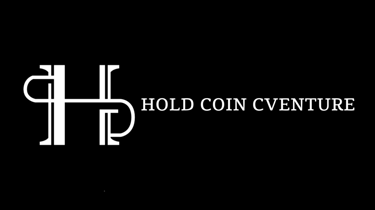Ethereum Reserves and the New Strategic Race
The Ethereum reserve race is the hottest topic at the moment, with a period when the inflow of ETFs into Ethereum surpassed that of Bitcoin in the weekly index. Recently, Ethereum ETFs have continuously held inflows of more than 1 billion USD per week.
INSIGHTS
8/17/202514 min read
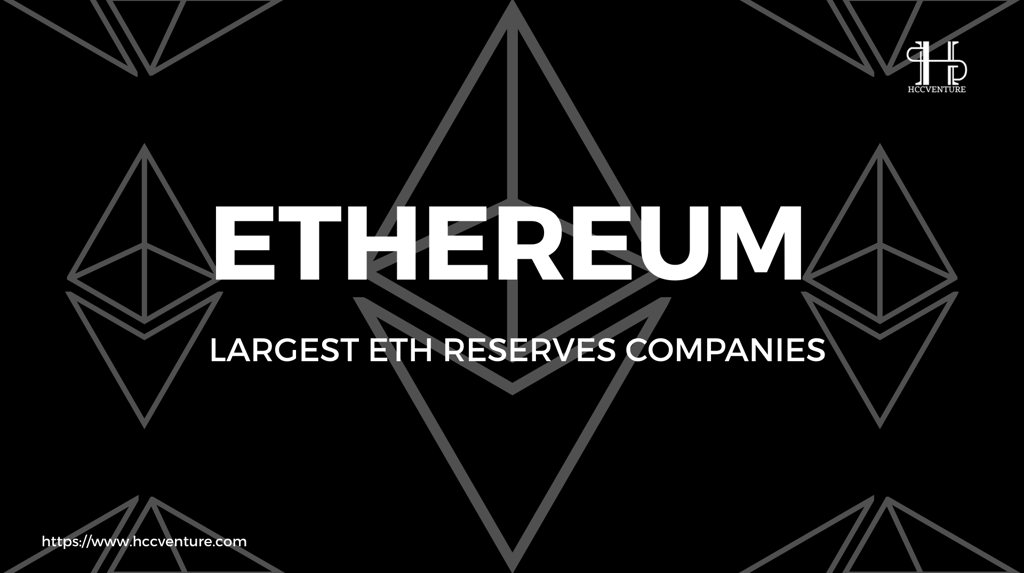

Market context
Strategy (MSTR, formerly MicroStrategy)’s bold move— using financial instruments to amplify exposure to Bitcoin (BTC) —marked a pivotal moment, spurring a wave of corporate adoption of digital assets. Since then, more than 50 institutions have adopted Bitcoin- focused treasury strategies , following Saylor’s lead, and the number continues to grow. At the same time, a separate group of businesses is emerging that is pursuing a different path: one that sees cryptocurrencies not just as a reserve asset, but one that is directly tied to the underlying economic dynamics of the Ethereum network.
This paper examines the first four public companies in the United States to establish Ethereum reserves . We examine funding channels, measure “ ETH concentration ” ( the amount of Ethereum owned per share ), and assess the premiums placed on Ethereum-backed financial products, including ETH-backed Treasury bonds. In addition to financial metrics, the study highlights the long-term implications for the health of the Ethereum network, staking mechanisms, and DeFi infrastructure. We argue that these Ethereum reserve techniques not only transform corporate balance sheets, but also immediately reallocate resources to the core of the decentralized economy that Ethereum is developing.
Ethereum Company Profile and Reserve Strategy
SharpLink Gaming - SBET
SharpLink Gaming Ltd. (Nasdaq: SBET) , founded in 2019, is a digital technology company that turns sports fans into bettors by connecting them to sports betting and interactive gaming through its proprietary platform. The company creates free-to-play games, mobile apps, and marketing services for leagues, teams, and bookmakers, and manages real-money fantasy and simulation sports games, serving over 2 million members, with a total spending of approximately $40 million per year. SharpLink operates in all U.S. states where online betting and fantasy sports are permitted.
June 2025 was a major turning point for SharpLink as it was the year the company first added ETH to its balance sheet. These purchases were funded by a $425 million private investment in public equity (PIPE) and an at-the-market offering (ATM ). Management emphasized that this strategy reflects a strong belief in Ethereum as a programmable, profitable digital asset that directly benefits through staking and other profitable opportunities in the DeFi ecosystem. SharpLink’s Ethereum treasury strategy is designed to complement, not replace, the company’s core gaming and sports betting businesses.
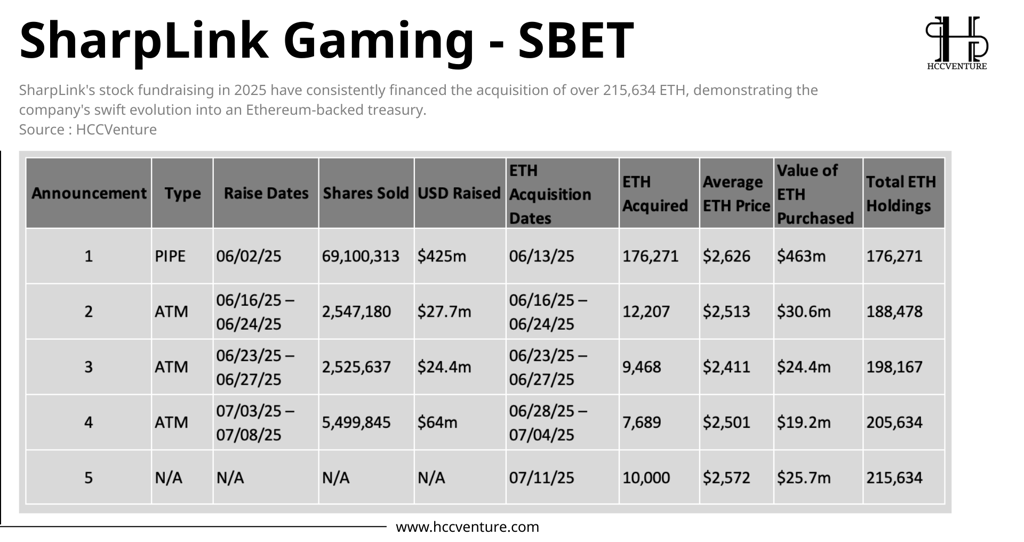

SharpLink successfully raised and allocated equity capital over five weeks to purchase over 215,634 ETH . Purchases were made continuously from June 13, 2025 to November 7, 2025. The average purchase price was between $2,411 and $2,626 per ETH , indicating that the accumulation strategy is flexible enough to respond to market changes. As a result, SharpLink has quickly become the largest public company in the United States holding ETH in treasury.
The key point here is that SharpLink has staked its entire ETH reserve. From June 28 to July 4, the company received 100 ETH in rewards . This brings the total staking rewards to 322 ETH since the program began on June 2, 2025. This shows that this strategy is not only for making money but also directly related to the security and stability of the Ethereum network . This helps diversify the validator pool and align corporate capital in a way that is in sync with the decentralized economy.
SharpLink’s Ethereum treasury strategy represents a shift in how companies manage capital: from traditional asset-based reserves to digital asset reserves based on proof -of-stake mechanisms . While ETH prices are volatile, the ability to generate long-term returns through staking and direct participation in the Ethereum infrastructure offers businesses a new way to manage money. SharpLink has become a “ pioneer ” in the on-chain treasury model by rapidly assembling and deploying capital. This has made corporate capital a vital part of the decentralized economy.
BitMine Embedded Technology - BMNR
BitMine Immersion Technologies Inc. (NYSE-American: BMNR) , headquartered in Las Vegas, is a blockchain infrastructure company specializing in industrial-scale Bitcoin mining, as well as providing immersion cooling hardware and third-party mining equipment hosting services in low-power locations such as Texas (USA) and Trinidad. This role positions the company in the cryptocurrency mining ecosystem as both a direct miner and a service provider.
BitMine conducted a private offering of 55.6 million shares ( at $4.50 per share ) on June 30, 2025. The total amount raised was $250 million . Tom Lee, co-founder of Fundstrat and one of the most important strategists in the crypto industry, became chairman of the board after this deal. This further solidifies the long-term strategic direction of the Ethereum (ETH) allocation.


SharpLink successfully raised and allocated equity capital over five weeks to purchase over 215,634 ETH . Purchases were made continuously from June 13, 2025 to November 7, 2025. The average purchase price was between $2,411 and $2,626 per ETH , indicating that the accumulation strategy is flexible enough to respond to market changes. As a result, SharpLink has quickly become the largest public company in the United States holding ETH in treasury.
The key point here is that SharpLink has staked its entire ETH reserve. From June 28 to July 4, the company received 100 ETH in rewards . This brings the total staking rewards to 322 ETH since the program began on June 2, 2025. This shows that this strategy is not only for making money but also directly related to the security and stability of the Ethereum network . This helps diversify the validator pool and align corporate capital in a way that is in sync with the decentralized economy.
SharpLink’s Ethereum treasury strategy represents a shift in how companies manage capital: from traditional asset-based reserves to digital asset reserves based on proof -of-stake mechanisms . While ETH prices are volatile, the ability to generate long-term returns through staking and direct participation in the Ethereum infrastructure offers businesses a new way to manage money. SharpLink has become a “ pioneer ” in the on-chain treasury model by rapidly assembling and deploying capital. This has made corporate capital a vital part of the decentralized economy.
BitMine Embedded Technology - BMNR
BitMine Immersion Technologies Inc. (NYSE-American: BMNR) , headquartered in Las Vegas, is a blockchain infrastructure company specializing in industrial-scale Bitcoin mining, as well as providing immersion cooling hardware and third-party mining equipment hosting services in low-power locations such as Texas (USA) and Trinidad. This role positions the company in the cryptocurrency mining ecosystem as both a direct miner and a service provider.
BitMine conducted a private offering of 55.6 million shares ( at $4.50 per share ) on June 30, 2025. The total amount raised was $250 million . Tom Lee, co-founder of Fundstrat and one of the most important strategists in the crypto industry, became chairman of the board after this deal. This further solidifies the long-term strategic direction of the Ethereum (ETH) allocation.
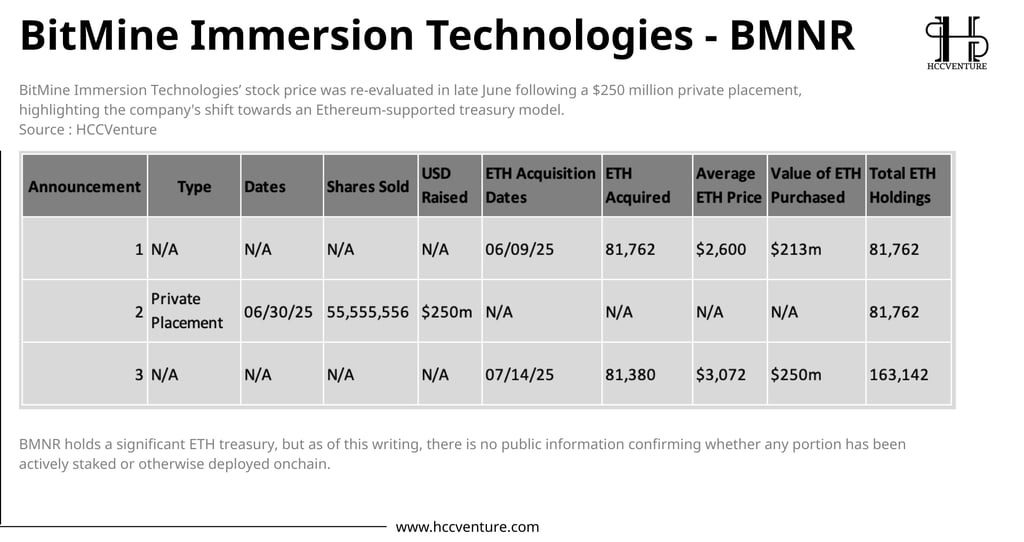

Prior to the fundraising, on June 9, 2025, BitMine purchased 81,762 ETH at an average price of $2,600/ETH, worth approximately $213 million . Following the private placement in late June, the company continued to increase its reserves. On July 14, 2025, the company purchased an additional 81,380 ETH at an average price of $3,072/ETH, worth $250 million. This brought the company’s total ETH holdings to 163,142 ETH , making BMNR one of the largest public companies in the United States to own an Ethereum treasury.
BitMine has a lot of ETH, but at the time of writing, there is no public information confirming that they have used staking or other on-chain activities for this reserve. This leaves a big gap: although SharpLink (SBET) has built the entire staking part, BMNR still holds ETH passively. This discrepancy could be due to the company's own additional issuance/accounting solutions, information disclosure risks, or liquidity management strategies.
BMNR’s plans to expand into Ethereum are a major change for the company. It will no longer just mine Bitcoin; it will also build blockchain infrastructure that includes both PoW (Bitcoin) and PoS (Ethereum) assets on its balance sheet. However, BitMine is currently in the asset accumulation phase, unlike SharpLink, which uses staking to earn money and is tied to the Ethereum infrastructure.
The aggressive dilution of shares ( more than 13 times the number of outstanding shares ) to raise capital shows how costly this strategy is and how it balances the interests of shareholders with the goal of building a large Ethereum reserve. If BMNR starts staking in the future, the company could move from a “ passive holder ” to an “ active participant ” in the Ethereum infrastructure. This would make the company more profitable and strengthen its strategic position in the decentralized economy.
Bit Digital Inc Mining Company - BTBT
Bit Digital Inc. (Nasdaq: BTBT) was founded in New York in 2015 and was one of the largest industrial Bitcoin mining companies at the time. The company operates in the United States, Canada, and Iceland. Over the past decade, the company has transitioned from a Bitcoin-based (PoW) mining model to a platform for a wider range of digital assets. This shows that the company is adapting to changes in the global cryptocurrency market.
In June and July 2025, the company conducted a public equity offering of about $172 million and sold 280 BTC ($30.5 million). This was a major turning point. All the capital was invested back into Ethereum (ETH), increasing ETH reserves from 24,434 ETH to 100,603 ETH. This decision was made by CEO Sam Tabar, a well-known expert on digital assets. This shows that Bit Digital is moving to an Ethereum-based model.
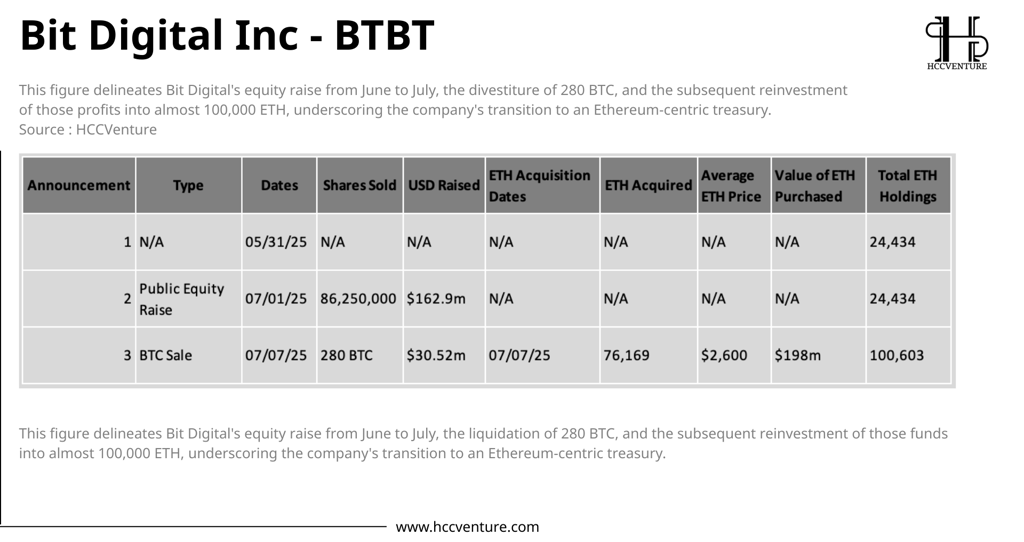

Prior to June 2025, Bit Digital held approximately 24,434 ETH , with over 21,500 ETH actively staked. This would yield an average annual return of 3.2% in 2024. After July 2025, the company purchased an additional 76,169 ETH at an average price of $2,600/ETH , worth approximately $198 million. This brings the company’s total ETH holdings to over 100,000.
The move also signals a shift in two strategies:
(i) Diverging from the usual role of accumulating BTC on the balance sheet.
(ii) Prioritize ETH as a profitable financial asset through staking.
The company has not disclosed how much ETH has been staked following the reserve expansion, but historical data suggests that staking is an important part of BTBT’s financial strategy. The company will likely continue to stake a large portion of the more than 100,000 ETH it has accumulated since 2024. This will help increase yields and solidify BTBT’s position as an infrastructure participant in the Ethereum network.
In the era of proof of stake, public companies have changed the way they think and use capital by shifting from “store of value” to “earning asset”. With this move, Bit Digital not only changes its balance sheet structure but also deepens its involvement in Ethereum infrastructure, solidifying its position as one of the pioneers in decentralized treasury governance (on-chain treasury management).
GameSquare Holdings - GAME
GameSquare Holdings (Nasdaq: GAME) is a Texas-based gaming media company that owns popular brands such as FaZe Clan, Stream Hatchet, and GCN. The company focuses on creating creator-led content and marketing for advertisers worldwide. The company also directly targets the Gen Z gaming community, a very important consumer group in the digital economy.
GameSquare raised $8 million in July 2025 by selling 8.4 million shares to the public. The money was used to launch an Ethereum fund program with Dialectic, with the ultimate goal of deploying up to $100 million in ETH . Notably, the strategy targets returns of 8% to 14%, which is 2 to 3 times higher than the typical Ethereum staking rate.
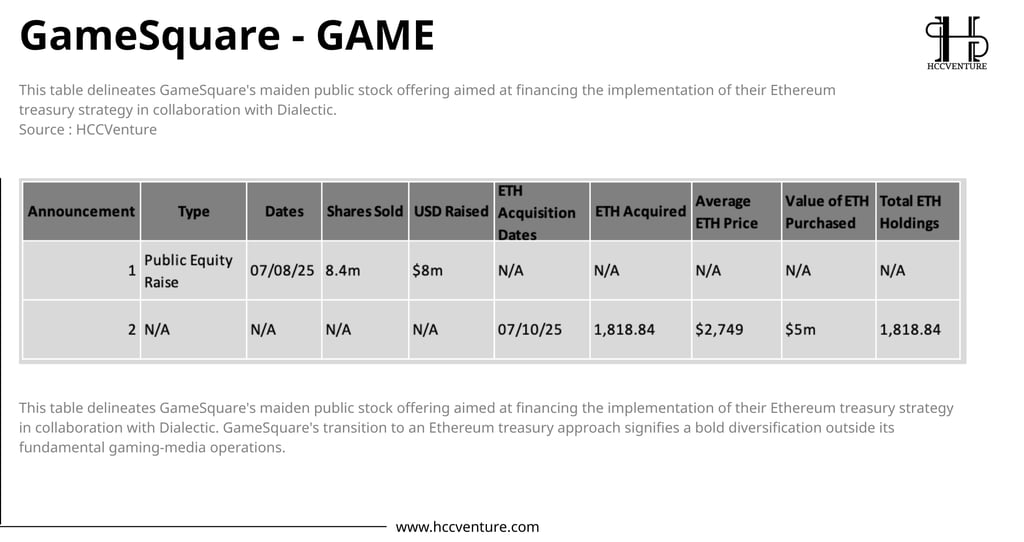

GameSquare purchased approximately 1,818.84 ETH at an average price of $2,749/ETH on July 10, 2025. This ETH is worth $5 million . The company now officially owns 1,818.84 ETH on its balance sheet, meaning it has entered the digital asset market.
GameSquare's strategy is to grow slowly, and if the program is fully implemented, the scale could reach $100 million in ETH . Currently, the amount of ETH that GameSquare holds is still small compared to other companies such as SharpLink (SBET) or BitMine (BMNR).
GameSquare is different from other companies that only do direct staking. They want to leverage their partnership with Dialectic and the Medici platform to turn ETH into DeFi and make the most of their investments. This could include:
Provide liquidity to important DeFi protocols (making buying and selling easier).
Engaging in yield farming strategies can be risky.
Use decentralized financial infrastructure instead of systems that only allow you to stake.
If successful, the company could achieve returns of 8% to 14% , much higher than the 3% to 4% returns that direct staking on Ethereum typically provides.
Instead of simply treating ETH as a passive reserve asset, GameSquare leverages corporate capital to directly participate in the DeFi ecosystem , turning its balance sheet into an active financial instrument. Injecting corporate capital into DeFi protocols not only benefits GameSquare, but also increases liquidity, diversifies validators, and promotes system stability , directly contributing to the growth of the Ethereum network.
Ethereum Concentration Index
SharpLink Gaming (SBET) has created the ETH Concentration Index, a quantitative measure that aims to ensure that public companies developing asset-based investment strategies have the same level of exposure to Ethereum (ETH). Specifically, the index is calculated by dividing the total ETH held (or expected to be held) by 1,000 outstanding dilution shares .
This index includes all possible diffusion stocks from:
Warrants,
Stock option,
Convertible tools.
We collect voting power and ETH holdings data from company filings, Bloomberg, SEC supporting documents, and professional financial databases. This ensures consistency across companies and comparability.
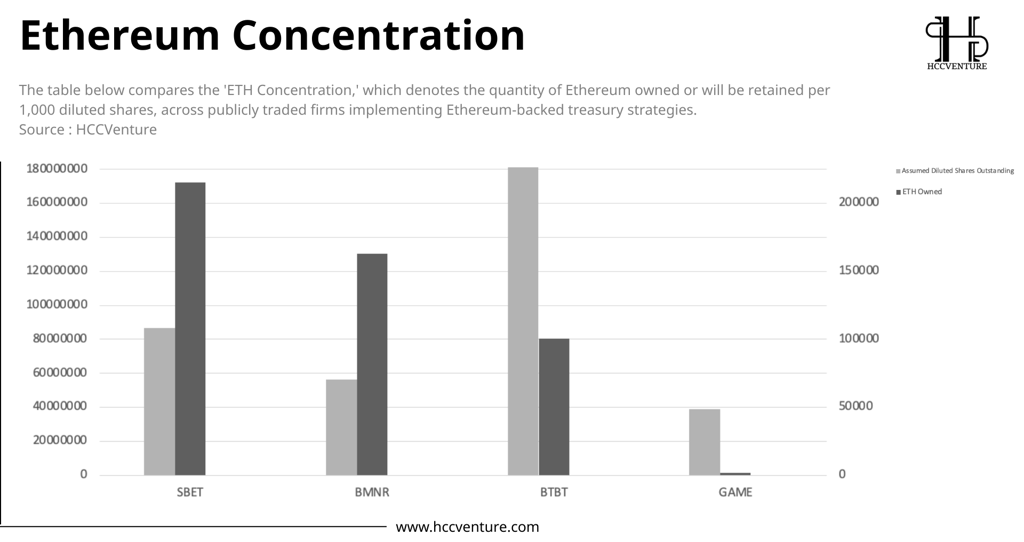

The ETH Concentration Index provides a simple yet effective tool for investors to:
Quantify ETH exposure on a per share basis, rather than just looking at absolute ETH amounts.
Compare per-share exposure between companies with different capital structures and funding sizes.
Assessing risk and profit potential among companies with high ETH Concentration means greater capital concentration in Ethereum , thereby increasing the profitability of staking/DeFi while facing more pronounced ETH price volatility.
The chart shows the big differences between the four public companies leading the way in integrating Ethereum into treasury:
SharpLink Gaming (SBET) owns the most ETH (around 215,000) and a lot of shares, thanks to a large modular fundraising strategy using PIPEs and ATMs.
BitMine Immersion Technologies (BMNR) has over 163,000 ETH, but due to the large stock split, ETH density per 1,000 shares is lower than SharpLink.
Bit Digital (BTBT) after switching from BTC to ETH, they now have around 100,000 ETH. Although the plan is to create a structure that replicates the dark treasury, the average ETH density per share is lower than expected due to too many shares in circulation.
GameSquare (GAME) is a new Ethereum startup that currently has around 1,819 ETH. The company wants to use DeFi to increase profits, which will open up new models for centralized betting media companies. The capital is small, but the company wants to grow.
Corporate Premium vs. ETH Treasury Book
Investors can use market premiums and ETH fund book values to see how the market values companies using Ethereum fund strategies.
A higher multiple means that investors believe the company is worth more than its ETH assets. They also believe that the company's capital management strategy, staking/DeFi yields, and business growth prospects make it more valuable.
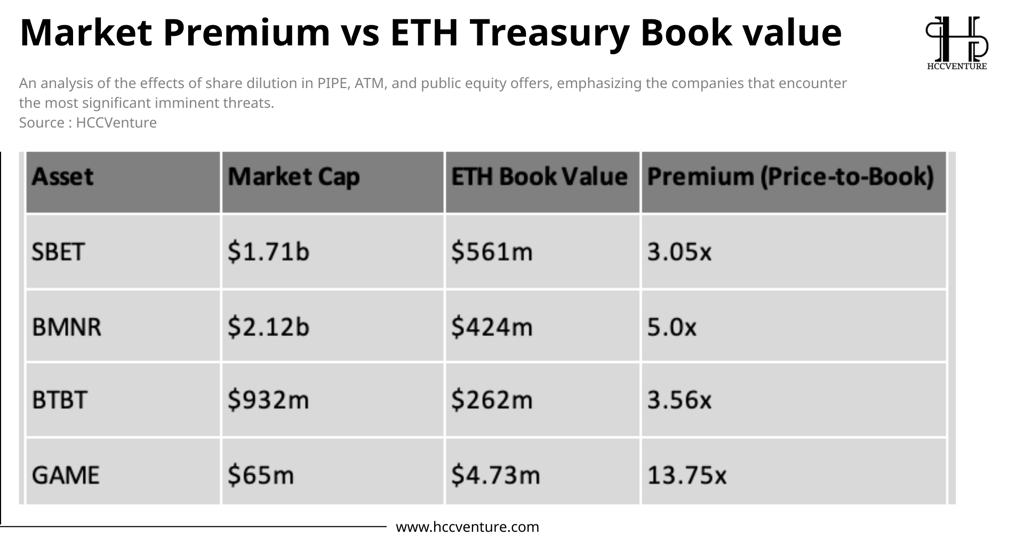

GameSquare (GAME) has a Premium of around 13.75x, which is the highest. This shows that the market is very optimistic, even though the company only has $4.7 million in ETH. This shows what people think about the DeFi yield model and the early stages of ETH accumulation. However, this high multiple also means that the ETH price is likely to fall sharply if the ETH price drops or DeFi deployment plans do not go as planned.
BitMine Immersion Technologies (BMNR) is currently trading at a premium of around 5.0x as the company recently raised $250 million in a private funding round. Investors believe that the large ETH holdings and Tom Lee’s presence on the board will make the company worth more than ETH itself.
Bit Digital (BTBT) has a Premium of around 3.56x, meaning the company is quite highly valued. Investors have noticed the strategic shift from BTC to ETH, but they are still pricing it quite conservatively because of the risk of dilution and staking returns at the new scale have not yet proven to be sustainable.
SharpLink Gaming (SBET) Premium ~3.05x, the lowest in the group. This shows that the market mainly expects stable staking returns from large ETH holdings (more than 215,000 ETH) rather than strong growth. Companies using ETH fund management strategies can consider this as a stable option with less risk of depreciation.
The Rise of Ethereum Treasury
The launch of the Ethereum Treasury represents a major shift in the way public companies represent digital assets on their balance sheets. Bitcoin Treasuries are defined as a passive storage strategy, similar to “digital gold,” that maintains or increases value through price fluctuations. Ethereum Treasuries, on the other hand, create a new type of value: yield-earning assets.
The key difference is that ETH is not just a store of value; it also allows you to generate active cash flow through staking systems and decentralized finance (DeFi). This shift from “capital preservation” to “capital growth” means that corporate treasury management is undergoing a structural revolution.
ETH assets have moved from “passive reserves” to active capital, improving cash flow and enabling better balance sheet management tools. This is a combination of “strategic assets” and “income-generating assets”, resulting in a larger margin of financial efficiency.
When corporate treasuries stake more coins, it helps the validator base become more stable and predictable. This makes the network more secure, more liquid, and healthier. As of July 9, over 35 million ETH has been staked, representing over 30% of the total supply. Part of the reason may be that listed companies are participating.
The ETH Treasury is more than just a way to manage money; it is a way to connect businesses and protocols. When businesses try to make money while also helping to keep the network secure, they become dual actors. They receive economic benefits and add infrastructure capital to the decentralized economy.
Big dilution happens, who will face it?
Investors need to think carefully about how to finance equity, especially PIPE transactions, which introduce new shares into the market, dilute the value of existing shares, and put downward pressure on the stock price. BitMine’s large PIPE offering makes the company particularly vulnerable to dilution and volatility in the near term. SharpLink’s use of both the PIPE and ATM methods creates immediate dilution and maintains the pressure. On the other hand, the more traditional and open public offerings of Bit Digital and GameSquare make the dilution more visible and reduce the risk of losing money in the market. Finally, companies that choose the PIPE structure have a higher risk of initial market impact, especially when the market is volatile, compared to ATMs and traditional public offerings. However, all of these equity-focused strategies avoid the highly leveraged convertible bonds commonly found in the Michael Saylor model at Strategy.
Evaluation and Conclusion
At first glance, the extreme volatility of Ethereum fund shares may seem similar to the boom-and-bust cycles seen in memecoins. However, the first group of ETH fund companies used very different strategies. These companies did not rely on hype or passive exposure to Ethereum. Instead, they actively positioned it as a yield-generating reserve asset, staking it for principal returns, or even using it in more advanced DeFi strategies in some cases. This is different from the first Bitcoin funds, which used a passive “digital gold” model and often used highly leveraged convertible debt to fund their positions. On the other hand, current ETH fund companies, SharpLink, BitMine, Bit Digital, and GameSquare, all use equity to fund their strategies. This avoids the issues that arise with debt repayment and maturity.
Disclaimer: The information presented in this article is the author's personal opinion on the cryptocurrency field. It is not intended to be financial or investment advice. Any investment decision should be based on careful consideration of your personal portfolio and risk tolerance. The views expressed in the article do not represent the official position of the platform. We recommend that readers conduct their own research and consult with a professional before making any investment decisions.
Compiled and analyzed by HCCVenture
Follow HCCVenture here: https://linktr.ee/holdcoincventure
Explore HCCVenture group
HCCVenture © 2023. All rights reserved.


Connect with us
Popular content
Contact to us
E-mail : holdcoincventure_contact@hccventure.com
Register : https://linktr.ee/holdcoincventure
Disclaimer: The information on this website is for informational purposes only and should not be considered investment advice. We are not responsible for any risks or losses arising from investment decisions based on the content here.


TERMS AND CONDITIONS • CUSTOMER PROTECTION POLICY
ANALYTICAL AND NEWS CONTENT IS COMPILED AND PROVIDED BY EXPERTS IN THE FIELD OF DIGITAL FINANCE AND BLOCKCHAIN BELONGING TO HCCVENTURE ORGANIZATION, INCLUDING OWNERSHIP OF THE CONTENT.
RESPONSIBLE FOR MANAGING ALL CONTENT AND ANALYSIS: HCCVENTURE FOUNDER - TRUONG MINH HUY
Read warnings about scams and phishing emails — REPORT A PROBLEM WITH OUR SITE.
